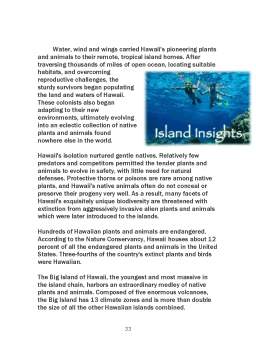Cuprins
- I.Motivation.page3
- II.Organizations.page5
- A.Greenpeace.page5
- III. Endangered Species.page8
- A. Threatened Animal species.page8
- B. Threatened plants species.page27
- IV. The Big Island’s Flora and Fauna.page31
- V.Pollution.page35
- VI.Conclusion.page40
- VII.Bibliography.page43
Extras din proiect
Chapter I
Motivation
Wildlife includes any animal, insect, aquatic, or land vegetation that forms part of any habitat. This includes all varieties of flora and fauna, what is popularly known as biological diversity.
Almost 440 million years ago, some 85 percent of marine animal species were wiped out in the earth's first known mass extinction. Roughly 367 million years ago, once again many species of fish and 70 percent of marine invertebrates perished in a major extinction event. Then about 245 million years ago, up to 95 percent of all animals—nearly the entire animal kingdom—were lost in what is thought to be the worst extinction in history.
Some 208 million years ago, another mass extinction took a toll primarily on sea creatures, but also some land animals. And 65 million years ago, three quarters of all species—including the dinosaurs—were eliminated.
Among the possible causes of these mass extinctions are volcanic eruptions, meteorites colliding with the earth, and a changing climate. After each extinction, it took upwards of 10 million years for biological richness to recover. Yet once a species is gone, it is gone forever.
The consensus among biologists is that we now are moving toward another mass extinction that could rival the past big five. This potential sixth great extinction is unique in that it is caused largely by the activities of a single species. It is the first mass extinction that humans will witness firsthand—and not just as innocent bystanders.
While scientists are not sure how many species inhabit the planet today, their estimates top 10 million. Yet each year thousands of species, ranging from the smallest microorganisms to larger mammals, are lost for good. Some disappear even before we know of their existence.
The average extinction rate is now some 1,000 to 10,000 times faster than the rate that prevailed over the past 60 million years. Throughout most of geological history, new species evolved faster than existing species disappeared, thus continuously increasing the planet's biological diversity. Now evolution is falling behind.
Only a small fraction of the world's plant species has been studied in detail, but as many as half are threatened with extinction. South and Central America, Central and West Africa, and Southeast Asia—all home to diverse tropical forests—are losing plants most rapidly.
Chapter II
Organizations
A.Greenpeace
Greenpeace is a global environmental organisation that acts to change attitudes and behaviour, to protect and conserve the environment and to promote peace.
In 1971, motivated by their vision of a green and peaceful world, a small team of activists set sail from Vancouver, Canada, in an old fishing boat. These activists, the founders of Greenpeace, believed a few individuals could make a difference.
Their mission was to "bear witness" to US underground nuclear testing at Amchitka, a tiny island off the West Coast of Alaska, which is one of the world's most earthquake-prone regions.
Amchitka was the last refuge for 3000 endangered sea otters, and home to bald eagles, peregrine falcons and other wildlife.
Even though their old boat, the Phyllis Cormack, was intercepted before it got to Amchitka, the journey sparked a flurry of public interest.
The US still detonated the bomb, but the voice of reason had been heard. Nuclear testing on Amchitka ended that same year, and the island was later declared a bird sanctuary.
Today, Greenpeace is an international organisation that prioritises global environmental campaigns.
Based in Amsterdam, the Netherlands, Greenpeace has 2.8 million supporters worldwide, and national as well as regional offices in 41 countries.
Greenpeace is present in 40 countries across Europe, the Americas, Asia and the Pacific.
They exist to expose environmental criminals, and to challenge government and corporations when they fail to live up to their mandate to safeguard our environment and our future.
In pursuing their mission, they have no permanent allies or enemies. They promote open, informed debate about society's environmental choices. They use research, lobbying, and quiet diplomacy to pursue our goals, as well as high-profile, non-violent conflict to raise the level and quality of public debate.
And they believe that the struggle to preserve the future of our planet is not about us. It's about you. Greenpeace speaks for 2.8 million supporters worldwide, and encourages many millions more than that to take action every day.
They take the name of our flagship, the Rainbow Warrior, from a North American Cree Indian legend. It described a time when humanity's greed has made the Earth sick. At that time, a tribe of people known as the Warriors of the Rainbow would rise up to defend her.
Preview document
Conținut arhivă zip
- Flora and Fauna.doc






















































